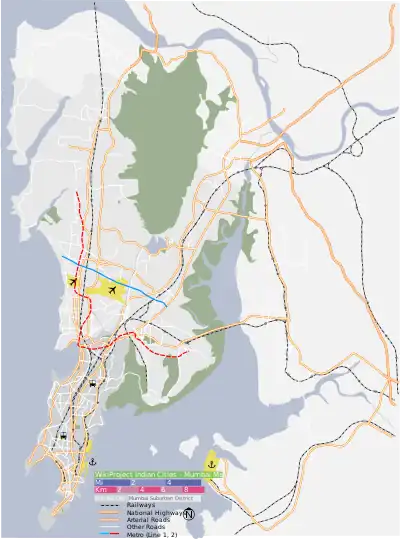Colaba railway station
Colaba Railway Station was a railway station on the Bombay, Baroda and Central India Railway (BB&CI) located in Colaba in then South Bombay (now South Mumbai.)
Colaba Railway Station | |
|---|---|
| Mumbai Suburban Railway station | |
| General information | |
| Coordinates | 18°54′58″N 72°49′29.5″E |
| Owned by | Bombay, Baroda and Central India Railway |
| Line(s) | Western Line |
| Platforms | 3 |
| Tracks | 18°54'58.0"N 72°49'29.5"E |
| Construction | |
| Structure type | Standard on-ground station |
| History | |
| Opened | 1872/1873 |
| Closed | 31 December 1930 |
| Rebuilt | 7 April 1896 |
| Services | |
|
No service demolished
| |
| Location | |
 Colaba Station Location within Mumbai | |
The original BB&CI terminus was at Grant Road. This was subsequently extended to Churchgate in 1870 and to Colaba, at the southern tip of the island, in 1873. However, by the 1920s, the Government of Bombay ordered the Railway to hand over the section between Churchgate and Colaba to facilitate the development of Backbay Reclamation project, now Nariman Point. After the new Bombay Central station was opened in 1930, the line between Churchgate and Colaba was closed and removed.[1][2]
The Old Station
By 1864, the BB&CI Railway established foothold in the city, with its terminus at Grant Rd. The line was then extended to the Bombay Backbay station by 1866, and started its regular local service to Viraur the following year. In the year 1872, the railway obtained permission from the Bombay Government to extend the line to Colaba, and build a goods station. The station was built, but permission was provided only to erect only a semi-permanent structure mainly out of timber, this too on the condition that the 'railway'(line) would be shifted to some other location between Colaba and Marine Lines, if any further reclamation scheme required it. This came into effect later, in 1930.
The Problems
As the passenger traffic grew, the station became cramped. Standing trains could only be accommodated at Grant rd, and it became necessary for three daily main line passenger trains to be taken back between Grant Rd and Colaba line, empty. To add to it, light engines had to move between Parel and Colaba continuously (since the shed was at Parel), hence affecting traffic. Also, often mainline trains had to be shunted off to provide space for Suburban trains, notably even before the passengers of the former could take their luggage out.
Thoughts were that this problem could be tackled by the provision of an additional siding at Marine Lines railway station, and making the station a terminus for long distance trains. In 1888, a government referred committee stated that this wasn't a 'satisfactory' arrangement, since it would be objected by people for using the limited area for recreation. Instead, it was recommended that expanding the station was the only permanent solution, and a block of land was provided to the railway between the Wodehouse Bridge road and Lower Colaba road.[3]
A New station is built
A new station was built on the site, and a new Colaba Station was opened on 7th April 1896. The new station consisted of a stone facade and a carriage porch at the South, a tower with a pitch tiled roof was located at its southwest corner. The station had three platforms, all about 500 ft long.[4]
During a period of several remodeling schemes throughout the suburban line, Colaba also received attention. The signalling and yard arrangements were found inadequate, and finally a scheme was approved for the same in 1920.[5]
Reclamation and Demolition
In 1920s, when the Backbay Reclamation project was under progress, the government ordered that the section between Churchgate and Colaba be relinquished, to allow unrestricted access. Hence, a new terminus had to be built before this. A new Terminus was built at Bombay Central, and opened on 18th December 1930.
Colaba Terminus ceased to exist after the 31st of December 1930. The last local ran from Colaba that day to the northern end of the city. Then section was then dismantled by 1933, and the line then terminated at Churchgate.[6]
References
- "Once upon a time, WR was mocked as a 'waste of money'". The Indian Express. 9 December 2014. Retrieved 8 November 2020.
- "Amazing facts about Mumbai". 3 October 2018. Retrieved 6 October 2018.
- A Century of Suburban Service ,1961 Westrail News- https://wr.indianrailways.gov.in/cris/uploads/files/1392817958306-article2.pdf
- https://wr.indianrailways.gov.in/cris/uploads/files/1485248204984-65-66%20Sepecial%20Feature.pdf
- The Bombay Local and Suburban Train Service, Dec 1923. BB&CI Magazine- https://wr.indianrailways.gov.in/cris/uploads/files/1392817679390-article1.pdf
- https://wr.indianrailways.gov.in/cris/uploads/files/1392817958306-article2.pdf